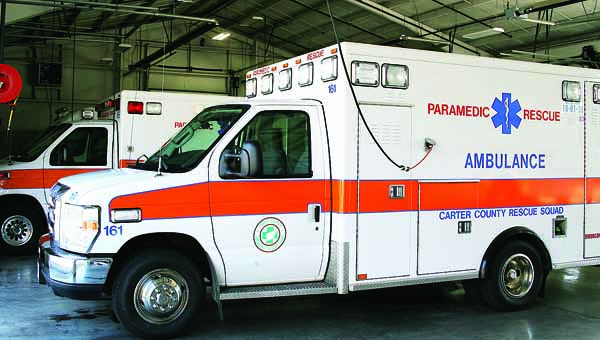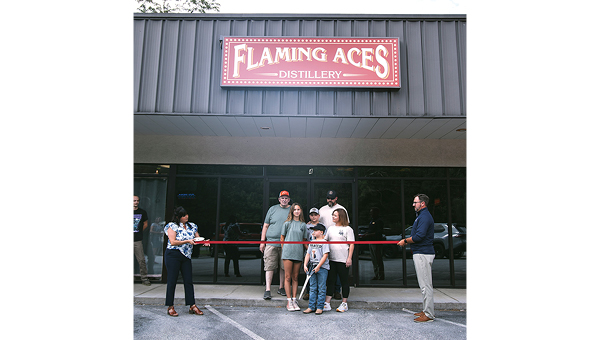Task Force recommends more funding for Rescue Squad
Published 5:34 pm Friday, August 12, 2016

Star File Photo
A report issued this week by the EMS Task Force launched earlier this year by the Carter County Commission notes the Carter County Emergency Rescue Squad has faced year after year of increased costs, including the costs of maintaining its fleet of ambulances in compliance with state and federal standards.
A Task Force appointed just over a year ago to review funding and operations of the Carter County Emergency Rescue Squad has submitted their final report to the County Commission and is recommending additional funding for the agency.
The EMS Task Force launched by the Carter County Commission was chaired by Commissioner Dr. Robert Acuff and included the following members: Jessica Bowers, RN, of Ivy Hall Nursing Home; Commissioner Sonja Culler, who chairs the county budget committee; Chris Hitechew, Director of Northeast State Community College at Elizabethton and the Johnson County EMS; Elizabethton City Councilman Sam Shipley; Anthony Roberts, Associate Director of Carter County Emergency Rescue Squad; Dwain Rowe, Program Manager for Wings Air Rescue; and Chris Williams, Chief of JCFD.
In the introduction of the report, the Task Force notes the main objective of the group was to review costs and make recommendations based on how other counties in the region operate, fund and administer their emergency medical services and rescue squad entities. The report notes the Task Force conducted a 5-10 review of financial reports based on five counties: Carter, Greene, Johnson, Unicoi and Washington.
“It should be noted that EMS for Carter County is the only service that provides both EMS and RS (rescue squad) services; all other counties separate the two functions if they have RS at all,” the report states.
The Task Force looked at many factors, the report said, including how much money the various EMS services receive in local government funding.
For the 2014-15 fiscal year, the Carter County Emergency Rescue Squad received $170,000 from Carter County and $20,000 from the City of Elizabethton for a total local government funding level of $190,000. By comparison, local government funding for neighboring counties for that same fiscal year came in at $42,000 in Johnson County; $132,000 in Unicoi County; $1,528,802 in Washington County; and $3,363,158 in Greene County.
The Task Force noted that funding was higher during the 2015-16 fiscal year for the Carter County Emergency Rescue Squad as the county allocated an additional $160,000 and the city allocated an additional $100,000, both as one-time contributions to the agency.
The Task Force broke the funding down even further, dividing it into an per citizen contribution rate on an annual basis. The annual per citizen contribution rate for Carter County residents — both city and county combined — is $4.53 per citizen.
By comparison, the per citizen contribution rates for surrounding counties is as follows: Johnson County $2.31; Unicoi County $7.19; Washington County $12.18; and Greene County $52.83.
The Task Force noted that local government funding for the Carter County EMS service has decreased over the past 10 years while funding for EMS agencies in neighboring Washington and Greene Counties has increased during that same time period. Unicoi County has also seen a decrease in funding while Johnson County has maintained the same level of funding over the past decade.
While the Carter County EMS has faced multiple cuts in funding from the local government level, the agency has also been hit with significant increases to the costs of supplies, medications and training for employees. The report notes that calls for service continue to increase — including calls for non-emergency transports or care.
According to the report, EMS agencies are also faced with changes to healthcare laws, including changes to how and how much they are reimbursed for services through Medicare, Medicaid and private insurance plans.
“EMS systems, whether private or public, receive very little if any funding from state or federal subsidies. In most EMS entities, they must seek operating cost from their patients,” the report states. “The fee for transport is based on the federal government’s reimbursement model for Medicare and Medicaid patients. Most private payers have also adopted this model.
“Seeking reimbursements for transport has proven to be insufficient to cover the costs incurred with EMS delivery. Nationally, Medicare and Medicaid patients make up 60 percent of those transported by EMS providers with similar statistics for our region,” the report continues. “In Carter County the individuals who receive their coverage under Medicaid (TNCare) make up 25 percent of the population while approximately 23 percent of the county’s population is at or below the Federal poverty level. Obviously, any resulting shortfall in revenue must be obtained from other sources or written off as bad debt. Most of the shortfalls come from private payers; however, these individuals make up less than 25 percent of the patients transported to the hospital by EMS.”
The report notes there are also significant “hidden costs” that an EMS agency incurs, such as the cost of readiness in having crews available 24 hours a day, 7 days per week whether they are on active calls or not. Additional hidden costs, according to the report, include the purchase of medication, advancing medical technology, equipment/vehicle replacement and the cost of caring for patients that refuse transport to the hospital.
One of the areas where EMS agencies have seen vast cost increases is in the purchase of specific medications required by federal and state mandate to be on board ambulances.
“Depending on the class of drug, pharmaceuticals in general have consistently outpaced inflation and has been the center of debate focused on one commodity that increases overall healthcare costs,” the report states. “Reviewing the CCEMS drug inventory, the overall cost increase in five years for drugs purchased by CCEMS has been in excess of a 1,700 percent increase.”
“Items mandated that must be on every BLS (Basic Life Saving) and ALS (Advanced Life Saving) vehicle has seen a significant increase plus the impact of ‘dated items’ that must be removed when they expire and replaced with items in date to meet federal and state mandates,” the report continues. “This is one of the hidden costs that patients and government officials never appreciate when considering EMS expense and the escalating healthcare costs. Likewise, the same argument can be made for soft goods — gauze bandages, transport blankets, etc. — and hard needs as well —trach tubes, IV access and lines, etc. — these items for EMS have increased over 280 percent in the same period.”
As part of the report, the Task Force listed several services provided by Carter County EMS to the community that are not billable services and therefore the agency receives no compensation for. Those include: standby emergency crews at high school football games, deceased body transports, specialty rescue teams, county resident rescue operations, police and sheriff’s department SWAT Team medical personnel, and transport of inmates for the Carter County Detention Center.
State and federal mandates have also increased the minimum training requirements for personnel who staff an ambulance while the cost of that training has increased as well.
In its conclusion, the Task Force notes that the members realize that all of their recommendations may not be implemented, but they hope each one is carefully considered by the city and county governing bodies.
Among the Task Force recommendations are increased funding from local governments to help sustain the EMS service.
“Given the low expended per capita cost for EMS it appears prudent to increase the contribution to CCEMS in order to maintain and insure the existence of this medical safety net in Carter County,” the report states. “Municipalities must contribute to the education, certification and re-certification for Paramedics, EMTs and other advanced training certificates in order to stabilize and insure a workforce pipeline.”
To accomplish the task of funding education, the Task Force offers a couple of options: A) establish a pool of funding for training in the budget for individuals to apply with the caveat of remaining with Carter County EMS for a specified period of time before applying to another emergency medical service; and B) partnering with Northeast State Community College and Milligan College to maintain a training program consistent with the county’s needs and work with state legislators to include as part of the funding mechanism for students to allow Tennessee Promise to support individuals seeking training.
The report also includes recommendations for Carter County EMS to work to develop partnerships with healthcare providers to seek additional roles that will generate funding and support EMS activities and to consider regional partnership with other EMS systems for the bulk purchase of pharmaceuticals and equipment.





